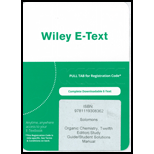
Concept explainers
Interpretation:
Reagents used are to be suggested in each part.
Concept introduction:
The reaction which occurs in between two esters or one ester and another carbonyl compound, and forms a carbon–carbon bond, in the presence of a strong base, leading to the formation of a β-keto ester or a β-diketone is known as Claisen condensation.
The removal of carbon dioxide from a carbonyl compound is termed as a decarboxylation reaction.
Sodium borohydride
Hydrogen bromide
Answer to Problem 1PP
Solution:
(a)
Sodium ethoxide
(b)
An acid
(c)
Heat
(d)
Sodium borohydride
(e)
Hydrogen bromide
(f)
Base
Explanation of Solution
The first step is similar to a crossed Claisen condensation. The reagent used in this reaction is sodium ethoxide. The molecular formula of sodium ethoxide is
The reaction shown is as follows:

The second step involves the hydrolysis of an amide that is lactamide, which can be carried out with either an acid or a base. In the given reaction the desired product is formed by using an acid.
The reaction is shown as follows:

The third step is the decarboxylation of a β-keto acid, which is formed by the acidic hydrolysis of an amide. It requires only the application of heat to get the desired product. The reaction takes place along with the second step.
The forth step is the reduction of the ketone, obtained in third step, into a secondary alcohol. There are many reducing agents, which can reduce a ketone into an alcohol, for instance, sodium borohydride. The molecular formula for the same is
The reaction shown is as follows:

The fifth step is the conversion of the secondary alcohol, obtained in forth step, to an alkyl bromide by using hydrogen bromide. This reagent also gives a hydrobromide salt of the aliphatic
The reaction shown is as follows:

The treatment of the salt with base will lead to the formation of the secondary amine. It will further act as a nucleophile and attack the carbon atom bearing the bromine. This reaction leads to the formation of a five-membered ring and (±) nicotine.
The reaction is shown as follows:

The reagents that could be used for each part are suggested as:
(a): Sodium ethoxide
(b): An acid
(c): Heat
(d): Sodium borohydride
(e): Hydrogen bromide
(f): Base
Want to see more full solutions like this?
Chapter H Solutions
ORGANIC CHEMISTRY-ETEXT REG ACCESS
 Organic Chemistry: A Guided InquiryChemistryISBN:9780618974122Author:Andrei StraumanisPublisher:Cengage Learning
Organic Chemistry: A Guided InquiryChemistryISBN:9780618974122Author:Andrei StraumanisPublisher:Cengage Learning
